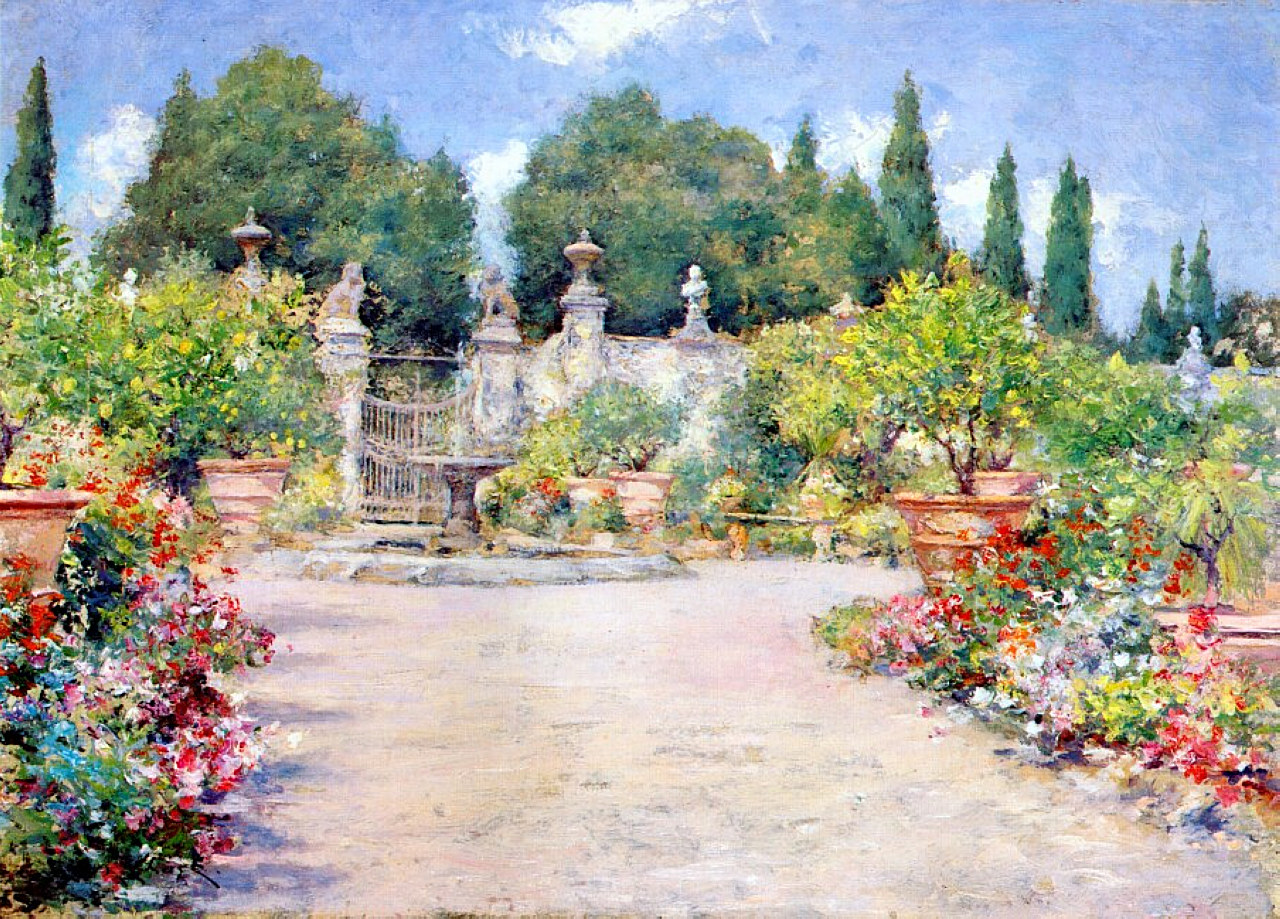American Impressionism and the popularity of gardening as a leisure activity is the focus of a major exhibition opening Oct. 3 at Reynolda House Museum of American Art. The museum will be the third of only five venues nationwide to host “The Artist’s Garden: American Impressionism and the Garden Movement, 1887–1920.” The exhibition will be on view in Winston-Salem Oct. 3, 2015–Jan. 3, 2016.
Other venues:
Pennsylvania Academy of the Fine Arts February 13 – May 24, 2015
Chrysler Museum of Art: June 16 – September 6, 2015
The Huntington Library, Art Collections & Botanical Gardens: January 23 – May 9, 2016
Florence Griswold Museum: Summer June 3 – September 18, 2016
This national exhibition, featuring what Philadelphia Magazine called “the best of the genre,” includes the work of the American Impressionist artists William Merritt Chase, Childe Hassam, Cecilia Beaux, Maria Oakey Dewing, Frederick Carl Frieseke, John Twachtman, and J. Alden Weir.
Frieseke's Hollyhocks (Among the Hollyhocks) is among the many
iconic examples of American Impressionism in the exhibition.
“These artists were responsible for revolutionizing art in America by bringing Impressionism from France to America for the first time,” said Allison Slaby, Reynolda House curator. “They fell in love with the freshness, light, and color of French Impressionism and found that gardens, whether in Europe or America, were the perfect places to experiment with this new style.”
“The Artist’s Garden” is organized by themes that include American artists’ visits to European gardens, the enthusiasm for gardening among women, the urban garden, the artist’s garden, and the garden in winter. The exhibition and its accompanying catalog include representations of gardens across the United States and Europe.
Many artists in this period were avid gardeners who adapted their own yards to become subjects for their work. Their models included the great palace gardens of Europe, such as the Villa Corsi-Salviati near Florence, where
William Merritt Chase painted An Italian Garden in 1909, a spectacular sun-drenched study of formal walls and terraces.
Others preferred the more intimate flower-filled yards of Claude Monet, as seen in
John Leslie Breck's Garden at Giverny (In Monet's Garden), painted between 1887 and 1891, a scene of tall flowers crowding around a slender dirt path.
The exhibition explores these choices: how artists organized their gardens, what they planted, and why certain flowers were favorites.
During the late 19th and early 20th centuries, Impressionist artists who had studied en plein air (outdoors, often in the countryside) in France were bringing home lessons to apply in an American context. Paintings in “The Artist’s Garden” show domesticated landscapes set in the suburbs, or even in the middle of the city, such as
The Hovel and the Skyscraper by Childe Hassam (1859-1935), which shows New York’s Central Park.
Unlike the notion of Manifest Destiny that pervaded the paintings of American landscape artists such as Albert Bierstadt (1830-1902), these are domestic pictures about yards, parks, and gardens, often with urban backdrops—not imposing mountains.
At this time, industrialization had made its mark on the landscape; it also had made its mark on the garden movement. People had more free time for gardening in new suburban backyards, and railroads allowed for daytrips to the countryside—giving city dwellers a taste of nature. Scientific innovation was being applied to plants, creating hybrid varieties optimized for color or hardiness. While humans had long grown plants for reasons other than bare sustenance, the late 19th century saw an explosion of garden hobbyists. They in turn were provided with seeds, tools, and fertilizer by horticultural suppliers. These suppliers used new hybridizing techniques to create ever larger and brighter flowers and bigger and more colorful fruits and vegetables.

Philip Leslie Hale (1865-1931), The Crimson Rambler, ca. 1908, oil on canvas, 25 1/4 x 30 3/16 in. Pennsylvania Academy of the Fine Arts, Philadelphia, Joseph E. Temple Fund.
The Crimson Rambler by Philip Leslie Hale (1865-1931), shows a simple summer scene with a woman next to a cascade of roses. While completely bucolic and unthreatening, the painting is informed by modern life. It features a recently hybridized rose variety that had been developed using scientific techniques. Wildly popular, the Crimson Rambler was widely advertised in garden supply catalogs. Much like the fashionable dress and hat worn by the woman in the painting, this was an absolutely contemporary and sophisticated rose.
“Painters at the time depicted what was near and familiar to them, which also happened to be really modern at the time,” said Glisson. For example,
Snow, by John Henry Twachtman (1853-1902), shows the artist’s backyard covered in snow. Twachtman, a member of the new suburban class, lived in southern Connecticut close to the railroad so he could commute into New York City whenever he needed. Though not a farmer, he lavished care on his suburban yard.
Read Anna Marley's article, "The Artist's Garden: American Impressionism and the Garden Movement, 1887—1920," published in the 15th anniversary issue of Antiques & Fine Art magazine.
Catalogue
A fully illustrated catalog, awarded a David R. Coffin grant from the Foundation for Landscape Studies and published in conjunction with the University of Pennsylvania Press, accompanies the exhibition. In addition to an introduction and essay by Anna Marley, the publication features essays by Alan C. Braddock, James Glisson, Erin Leary, Katie A. Pfohl, Judith B. Tankard, and Virginia Grace Tuttle, along with a foreword by John Dixon Hunt.





